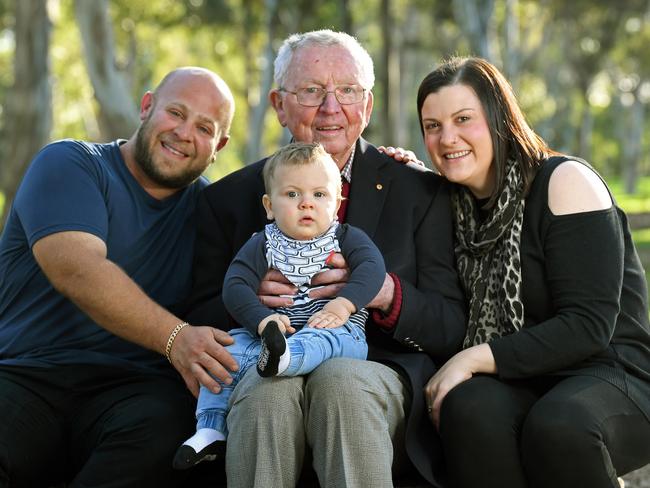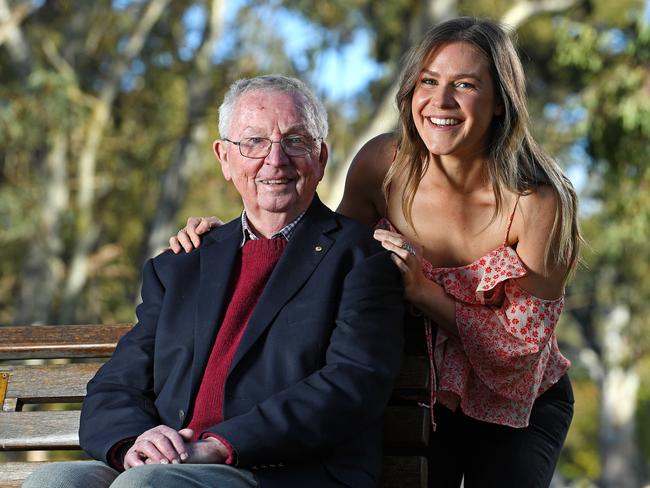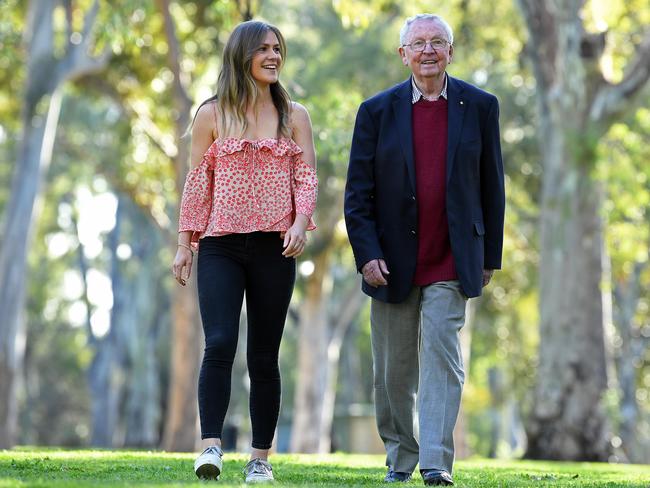A lifetime spent saving children
SEPTEMBER is International Childhood Cancer Awareness Month – and thanks to the dedication of pioneering doctors like SA’s Michael Rice, new drugs and better care, the chance of a child surviving cancer has improved enormously in the past half century.
LOOKING back on 50 years treating children with cancer in South Australia, Dr Michael Rice can now see that he’s paid a personal price for his dedication – not that he’d change a thing.
Today 82 and retired, Dr Rice was one of the pioneers in the heartbreaking business of treating kids with cancer – he was SA’s pre-eminent paediatric oncologist from the 1960s through to 2002, when he stepped down as the head of his department at the Women’s and Children’s Hospital.
Dr Rice estimates he treated more than 2000 patients with cancer in that time, but concedes the long hours and his commitment to these sick and dying young people led to him retreating emotionally from his own family – wife Judy and their six children.
“You had to suppress your emotions,” he says. “You went to the funeral of a child, and then you got a phone call to go and see someone else, so it was no use falling apart. I learnt to suppress emotions and Judy would say that became apparent, and our kids were affected to some extent and I think that’s true. I’ve had so many years of suppressing emotions that they’ve never really come back.

“There is a famous story in our family, from my son Andrew when he was about seven. I came home early one afternoon and I saw Andrew in the driveway and as I got out of the car he ran around the back and said, ‘Mum, Mum, something’s wrong. Dad’s home in the light’.”
Dr Rice couldn’t help going beyond the usual doctor/patient relationship. He remembers one child who was one of eight children and the family was struggling financially, so he called a mate at Nestle to organise baby formula to be delivered to their home. Another time he called the Electricity Trust and asked for a family’s bill to be put on hold. He attended funerals of patients – as pallbearer, in some cases – as well as birthday parties and weddings of those who survived.
“You had to help these families whose kids were dying,” he explains.
This personal connection came naturally to this gentle, considered man, but it was also sparked when a grieving mother came back to see him six weeks after her son died.
“She said to me, ‘there’s only one thing I thought you should have done – no one came to his funeral’. No one had ever said that to me and from that day onwards, I went to the kids’ funerals if I could,” he says. “I gave a eulogy on two occasions, one was a lad who had bone cancer who had battled – he was in his 20s when died. Another was a girl with leukaemia who had an early relapse and a very difficult time at the end where she was semiconscious for several weeks. I remember the families asking would I speak at the kids’ funerals.
“I said ‘I’d be honoured’ but it wasn’t easy. I then made it a practice to go to the children’s funerals because I realised what that mother said was right. Yes, the child has died but people need to know that you are still there.”
There is a ward at the Women’s and Children’s Hospital – The Michael Rice Centre – named in his honour. Dr Rice also received many prestigious awards including being made a Member of the Order of Australia in 2004. But just choosing the path of paediatric oncology back in the 1960s was unusual. Back then, the Adelaide Children’s Hospital (as it was known) had no specialised cancer unit and children with cancer were put in general wards.
“One of my mentors at the Royal Adelaide asked me what I was going to specialise in and I told him [paediatric oncology]. I’ll never forget it, he said, ‘Why on earth would you want to do that? There’s no hope, they all die’,” Dr Rice says. “I said, ‘Look I know what you are saying but I think something is happening and I want to be part of it.’

“In that era, I saw kids with cancer and we had access to a few drugs which had been shown to have effects in the short-term. I was just curious and thought, ‘why on earth could you get some children’s leukaemia to go away and then it would come back?’ I got more interested and thought I might like to pursue this further.”
In 1967, Dr Rice established the first specialised cancer unit for children at the Adelaide Children’s Hospital. He’d been gaining experience, working with Dr John Colebatch who had developed a cancer unit at the Melbourne Children’s Hospital, and at the Memorial Sloan Kettering Cancer Centre in New York. He did a stint at the Children’s Hospital in Boston, which produced the original report in 1948 that revealed that drugs could produce remission in leukaemia.
“By the time I got to the US, there were five different drugs that had an effect but we didn’t really know how to use them properly and we got responses but they were all short-lived,” he says. “At the time I started in this field, no child survived leukaemia. It wasn’t until the late 1960s that we started to see children with leukaemia who were remaining well – things had gotten better, we’d learnt how to use the treatment a bit better.
“What we learnt was that you had to intensify treatment in the early stages, whereas when I started it was often single drug treatment, but it developed into multiple drug treatments with very significant intensity over six months – and now almost nine months in some cases – and it’s very difficult for the family and the child.
“But the result has been survival. In the common form of acute leukaemia, called acute lymphoblastic leukaemia, it has risen from zero to 80 per cent. And it’s not just in that case. Acute myeloid leukaemia, more common in adults but it also happens in kids, has gone from zero to 60 per cent survival.
“Non-hodgkin lymphoma has gone from zero to 90 per cent survival rate, bone cancer from 15 to 60 per cent survival. So it’s an extraordinary change and improvement.”
However, towards the end of the 1970s, it became apparent that survivors of leukaemia were having learning difficulties and a series of studies revealed it was largely due to the radiation treatment of their brain. There were also cases of cancer spreading to their brain.
“Then a series of studies again established that we could remove radiation treatment given to prevent leukaemia spreading to the brain and replace it with drugs injected directly into the spinal fluid and that’s what we still do,” Dr Rice says. “The brain leukaemia incidence is now less than 10 per cent but the kids now have to have a series of lumbar punctures (spinal injections) and that is not easy, either.”
Advances in anaesthetic drugs have eased the pain for these children, who are now given a drug called midazolam to sedate them for procedures. “Instead of ‘midazolam’, the kids used to say I want to go to ‘Dazzeland’,” he laughs. “So ‘Dazzeland’ made it easier to do these procedures and that was a big help in making it easier to cope for us as doctors.
“Each of these milestones is very important. We started just wanting to get someone to live, we then wanted them to live a bit longer, we then wanted them to live a long time, we then wanted them to live in good health and we then needed to alter the earlier treatment program to get rid of some of the nasty things.
“Now we want them to take care of their health because other things have emerged down the track.”
Critical to his understanding of cancer was Dr Rice’s “little file”. In the 1960s, he began keeping handwritten notes on each patient. This proved to be one of the best decisions he made, he says, due to the value of this anecdotal evidence.
While he retired in 2002, Dr Rice continued to work from the Women’s and Children’s Hospital until 2012, contacting past patients and updating his file – vital information to telling the whole story of childhood cancer.
“We tried to set up a specific follow-up program at the WCH in the early 2000s but funding wasn’t provided so that fell over, so I started this follow-up myself – I was working part-time by then,” he says.
“We had lost (contact with) 30 per cent of the survivors so back in 2009, I started seriously trying to chase them. It wasn’t easy but I found a lot of them.
“So, I passed on the information that we now knew about risk factors, I got them to tell me whether they’d had any health problems so I could record that data. One of the disappointments that came out of it was how little we had been told about it. The medical system is not set up to share information like it was back in the day when we all saw just one GP for our lifetime. Information gets lost.”
It’s a problem that the health system doesn’t see that it’s essential to follow up patients. The SA Health Department refuses to pay for anyone over the age of 18 to attend the follow-up clinic at the Women’s and Children’s, and the adult system is too busy to know them, he says.
Prior to 1971, there were just three survivors of acute leukaemia in SA and, in that time, Dr Rice treated 54 patients. Those three people are still alive, he says proudly. “I meet one of them from time to time at the airport because he’s a traffic warden.” Another is a 52-year-old woman who now lives in Sydney, the longest known survivor of all of Dr Rice’s patients. It is these success stories that has kept him going, as well as the constant and incremental improvements in cancer treatment for children. “Besides suppressing emotions, the other thing that helped me stay is that it got better,” he says. “The burnout in this field was well-known because you were dealing with death all the time and that steady improvement that I saw from the beginning of the 1970s kept me going.”

Science now is learning what may cause cancer, and how acute leukaemia is not one disease but many, he says. The big drug firms are discovering ways to stop cancer cells developing and targeted treatments are coming. “New drugs are appearing on the horizon,” he says. “The best example is the drugs for melanoma. (Hawthorn footballer) Jarryd Roughead was riddled with melanoma, but he received treatment and is playing football at the highest level. Is he cured? I don’t know but he’s certainly lived a lot longer than he would have.”
Also vital to the success stories of survivors has been the rise of organisations such as the Childhood Cancer Association, which was established in 1982 by parents of children with cancer. Today it welcomes donations to help it offer support, counselling and services to families coping with childhood cancer. These include the SIBS program to help “super important brothers and sisters” of patients, home tutoring schemes for children receiving treatment, as well as accommodation for families travelling from the country and interstate. Dr Rice says this and other organisations such as Camp Quality, Ronald McDonald House, CanTeen and Make-A-Wish Foundation are also key when it comes to offering support to families grappling with this cruel disease.
Today, Dr Rice continues to get Christmas cards from the families of past patients. He and Judy are kept busy with their six adult children, and nine grandchildren.
He continues to strive for a balance between empathy and harsh reality. “You have to be sufficiently detached to tell a family there is no further treatment advisable – yet you can’t be,” he says. “It’s very hard to say ‘we need to switch to relief of pain and support for your child until death takes them’.
“I am sure it’s had an effect on the way I see life. I am far less demonstrative towards my children than Judy is because my emotions have been beaten out of me – but what sustains me through my work has been helping people.
“These people are going through this terrible time and you have to be prepared to give of yourself. Looking back on it all, I wouldn’t do anything differently.”
